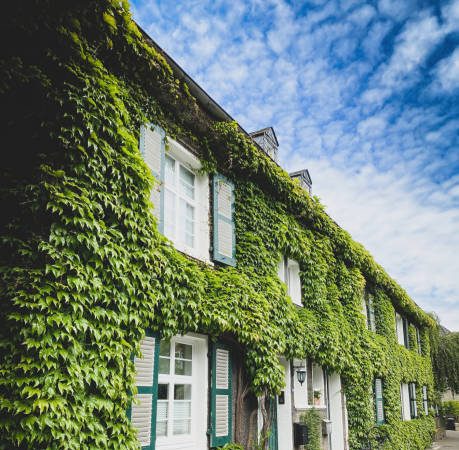The “green blanket” is a real explosion of colour in autumn. Just a quick word of advice: make sure you get the planting right, or you’ll end up regretting it.

What do you think of the green walls on the buildings? The right climbing plants will look great in summer and autumn, when some of them change colour. There are just a few things to bear in mind. Could climbing plants damage the façade? What’s the best way to plant them?
Some people think lianas on buildings are a bad thing. They say they cause damp, mould and even destroy walls. What’s the reality of the situation? Are ivy and other climbing plants damaging the exterior of buildings? They’re not responsible for damp. In fact, they help protect the façade and walls from the negative effects of weather.
Do climbing plants damage the façade?
We often hear about old buildings in England and France, where the climate is wetter than in Slovakia and where it’s typical for the facades to be covered with vines.
- Thanks to the climbing plants, water runs down them rather than directly onto the walls.
- The green layer on the façade is like insulation.
Thanks to it, the wall doesn’t get too hot during the day and cools down more slowly in the evening. However, there might be an issue if the mortar or the façade has fallen off and the plaster has already been damaged before the ivy was planted.
How to plant ivy by the wall? Before you get to work with a shovel, take one thing into consideration
How to attach climbing plants to the wall? You don’t really need to do any major work, as these plants have ‘suction cups’ that can be used to attach them to the building.
- Ivy forms adhesive roots that can penetrate through damaged plaster. However, it does not shed its leaves for the winter and cleans the air in the process.
I think a better choice would be the five-leaf and three-leaf baboons, which tend to cling to walls like suckers. They change colour in the autumn and shed their leaves in the winter.
You could also try wisteria, trumpet root, clematis and vines for creating green walls. On the other hand, pimpernel is best avoided. All climbing plants are perennials.
How to plant climbing plants?
- In early autumn or spring, plant them in the garden every 50-100 cm at a distance of about 40 cm from the wall of the building.
Vines grow quickly, so you may find that if they are spaced too densely they will develop more slowly and compete for space as well as water and nutrients.
- You need to prune the vines to encourage them to form new shoots, remove dead and woody shoots and make them more comfortable to grow.
Just a quick tip: It’s important to make sure your façade is ready before you start planting climbers. It needs to be treated and plastered well, with no cracks or crevices. If the wall isn’t plastered properly, the ivy won’t be able to hold itself up and will fall off with the façade. It’s also best not to plant ivy directly after plastering. It’d be a good idea to wait at least a year.

